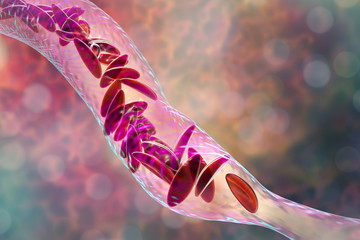
Cannabis May Mitigate Pain From Sickle Cell Disease
A study published in the July 2020 journal JAMA Network Open shows promising results for cannabis as an alternative to opioid pain relievers for patients with sickle cell disease. The double-blind, placebo-controlled trial was co-led by researchers Kalpna Gupta and Dr. Donald Abrams of University of California, Irvine (UCI) and UC San Francisco (UCSF), respectively.
The pioneering study represents an early effort to test whether the pain management properties of cannabis previously observed in animal studies cross over effectively in human trials.[i]
Sickle Cell Disease: A Cause of Chronic Pain
Sickle cell disease (SCD) is a genetic condition inherited at birth that causes normally round red blood cells to take on the crescent moon shape of a sickle, a defect that leads to rapid cell die-off and a shortage of healthy red blood cells in the body.[ii]
The most common clinical manifestations of SCD are vaso-occlusive crises, periods when microcirculation is obstructed resulting in chronic pain.[iii] The only known cure for SCD is a bone marrow or stem cell transplant,[iv] making pain management a top priority in SCD treatment protocols.

Opioid pain medications, the current primary treatment for SCD pain, have serious downsides including constipation, pruritus (itching), respiratory depression and risk of addiction and death from overdose.[v] Dr. Gupta and his research team set out to determine whether cannabis may be an effective alternative to opioids by testing inhaled cannabis compared to inhaled placebo for relief of chronic pain in adults with SCD.
Study methods in the pilot randomized clinical trial involved enrolling 27 participants from a pool of 90 individuals with a diagnosis of sickle cell disease with chronic pain. Participants were admitted into a designated inpatient clinical research center for two, five-day stays over a period of 32 months between 2014 and 2017.
Participants inhaled either vaporized cannabis or vaporized placebo three times daily for each of the five-day study periods. Of these initial 27 participants, 23 completed both treatment arms of the study and were included in the final analysis.
The final pool of study participants was comprised of 13 women and 10 men with a median age of 38 years. Cannabis used in the study had a 1:1 ratio of Δ-9-tetrahydrocannabinol to cannabidiol, two of the isolated active constituents of medical-grade cannabis. Daily pain indices were assessed and recorded using a visual analog scale and a standardized pain measurement index.
Cannabis Is Safe and Effective at Treating Chronic Pain
Findings in this study were somewhat mixed. Vaporized cannabis did not statistically significantly reduce pain and associated symptoms as compared to placebo. However, several factors did rate as significant potential benefits to the use of cannabis for treatment of chronic pain.
Primarily, inhaled cannabis was more effective than inhaled placebo in altering mood, a factor that is significant for patients dealing with chronic pain. Secondarily, inhaled cannabis was found to be safe and well-tolerated, a marked improvement over the high risks, including death by overdose, associated with opioid use.
Researchers concluded that cannabis should be investigated further in larger and longer clinical trials, as an adjunct or alternative to opioids in adults with sickle cell disease with chronic pain. According to Dr. Gupta:
"We don't know if all forms of cannabis products will have a similar effect on chronic pain. Vaporized cannabis, which we employed, may be safer than other forms because lower amounts reach the body's circulation. This trial opens the door for testing different forms of medical cannabis to treat chronic pain."[vi]
Cannabis Medicine: A Growing Movement
California, where this research study was conducted, is one of 11 states that have legalized small amounts of cannabis for adult use[vii] and is among 33 states, including District of Columbia, that have implemented medical marijuana programs. In these state-run medical programs, chronic pain is the most widely prescribed indication for cannabis treatment. [viii] Of the 33 states that have medical cannabis programs, only four states have included SCD as a qualifying condition.[ix]
The study authors acknowledge that people with SCD use cannabis at statistically higher rates than the general population, often obtaining the plant from unapproved sources, which increases their risk of exposure to adverse effects from substandard-quality medicine.[x] Such issues surrounding access result from ongoing criminalization of cannabis at the federal level.
A 2018 survey study of cannabis use by SCD patients found that, of the 58 adults screened, 42% reported cannabis use within the past two years.[xi] Among them, 92% said that they used cannabis for pain, with 79% of these patients reporting that using cannabis allowed them to use less prescription pain medicines.[xii]
Study authors noted that the safety profile of cannabis is one of the plant's primary advantages when compared with other pharmaceutical interventions. Since SCD patients are often prescribed multiple medications, the ability to prescribe a non-toxic and generally well-tolerated plant can "potentially help attenuate the ongoing public health crisis related to opioid use."[xiii]
Plant-Based Interventions Show Promise for Sickle Cell Disease
Sickle cell disease is the most common inherited blood disorder in the U.S., affecting an estimated 100,000 Americans.[xiv] SCD affects African Americans at a disproportionately high rate, with an estimated 1 in 500 affected in this population group.[xv]
Symptoms can range from mild to severe pain and repeated infections to complications from anemia that may be mild to so severe that organ damage can result. Due to this wide range of symptoms, there is no single best treatment for SCD.[xvi]
Studies on the severity of sickle cell disease markers in children have demonstrated links between inadequate nutritional intake, weight and BMI, indicating that good nutrition can play a part in wellness for SCD patients.[xvii]
A diet rich in fruits and vegetables provides a solid baseline for wellness regardless of age or health status, with many plants functioning as natural health tonics. The humble lime has demonstrated that intake of lime juice can reduce painful episodes, fever and hospital admission rate for sickle cell anemia in children.[xviii]
Vitamin and mineral deficiencies are at the root of many disease states and can make individuals more susceptible to symptomatic episodes. Magnesium supplementation has been shown to reduce symptoms of dehydration in SCD patients,[xix] while vitamin D deficiency has been linked to risk factors for acute and chronic pain as well as bone fractures in SCD patients.[xx]
Vitamin D deficiency is reported with high prevalence in SCD patients, providing context to the supposition that vitamin D supplementation may play a therapeutic role in remediating chronic pain associated with sickle cell anemia.[xxi] Vitamin C supplementation has also shown promise for children with SCD, thanks to its ability to improve oxygen saturation in the blood.[xxii]
To learn more about the benefits of a natural foods-based approach to health, consult the many articles and scientific abstracts on GreenMedInfo.com, the world's most widely referenced, evidence-based natural medical resource.
© [10/7/2020] GreenMedInfo LLC. This work is reproduced and distributed with the permission of GreenMedInfo LLC. Want to learn more from GreenMedInfo? Sign up for the newsletter here //www.greenmedinfo.com/greenmed/newsletter.
.jpg.aspx)
